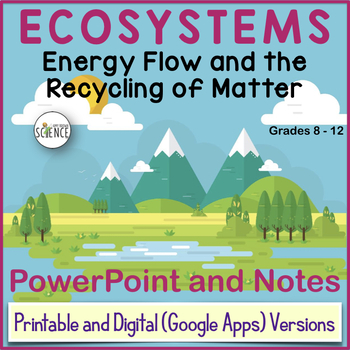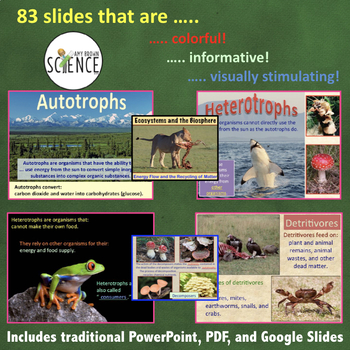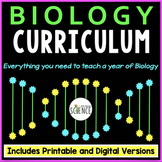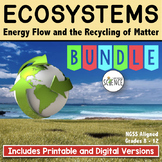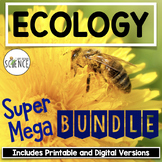Ecosystems PowerPoint and Notes - Matter Recycling and Energy Flow in Ecosystems
- Zip
- Google Apps™

What educators are saying
Also included in
- This NO PREP, PRINTABLE, EDITABLE, AND DIGITAL Biology Curriculum contains everything you need for an entire year of Biology! For less than $3 a day, you can save your time, energy, and sanity. Each of the 20 Complete Units includes a teaching PowerPoint presentation, notes, labs, homework assignmenPrice $525.00Original Price $988.18Save $463.18
- This "Ecosystems Complete Unit Bundle" covers the flow of energy through ecosystems, the recycling of matter, food chains and food webs, energy pyramids, biogeochemical cycles, and more. See complete list of topics covered below.This unit bundle includes everything you need to teach a unit on ecosysPrice $39.99Original Price $52.72Save $12.73
- All of my ecology and environmental science resources (6 ecology unit bundles) are included in this one Super-Mega-Bundle! This mega-bundle includes all of the PowerPoints, notes, labs, task cards, homework assignments, review games, quizzes, activities, and unit tests that you need to teach a compPrice $178.00Original Price $252.64Save $74.64
Description
This colorful and engaging 83-slide PowerPoint presentation, "Ecosystems: Energy Flow and the Recycling of Matter", will provide your students with interactive lessons on the ecological principles concerning the flow of energy through the ecosystems as well as the biogeochemical cycles (carbon cycle, water cycle, nitrogen cycle) responsible for the recycling of matter. Choose to use the traditional printable version, or the paperless, digital Google Apps version.
What is Included?
- 83-slide PowerPoint presentation (Includes traditional PowerPoint, PDF, and Google slides)
- Editable and Printable 12-page set of lecture notes for the teacher
- Editable and Printable 16-page guided notes outline for the student
- Paperless Digital Version for use in Google Drive, Google Classroom, and /or Microsoft OneDrive
This resource is perfect for distance learning and for students in 1:1 classrooms.
Click this link to view all of my Digital Resources.
Ecology is one of the "must-teach" topics for any biology or life science class. What would a good biology class be without a strong unit (or units!) in Ecology? This colorful and visually appealing PowerPoint is just what you need to spice up your ecology lessons. Our students are the decision makers of tomorrow. It is imperative that we give them the ecological knowledge (global warming, greenhouse effect, habitat destruction) they need so that they can make informed decisions about our future.
This PowerPoint is on "Ecosystems and the Biosphere: Energy Flow and the Recycling of Matter". It consists of 83 slides that are colorful, informative and visually stimulating. Pictures and diagrams are included that will greatly enhance your instruction to your students. Graphics, diagrams, clip art, and photographs were chosen to capture the attention of the student as the lesson is being taught.
Topics covered in this lesson are:
- Energy Flow Through the Ecosystem: Sunlight as a source of energy, importance of photosynthesis, conversion of energy into glucose and other organic compounds.
- Autotrophs, producers, examples of autotrophs, chemoautotrophs and chemosynthesis.
- Heterotrophs, consumers, examples of heterotrophs, herbivores, carnivores, omnivores, detritivores, decomposers, the essential nature of decomposition.
- Feeding Relationships: One way flow of energy through the ecosystem, food chains, examples of food chains, food webs, trophic levels, primary producers, primary consumers, secondary consumers, tertiary consumers.
- Productivity of the Ecosystem: Two ways to measure productivity, gross primary productivity, the role of glucose in productivity, biomass, net primary productivity, factors that determine productivity in both terrestrial and aquatic ecosystems.
- Energy transfer between trophic levels, ecological pyramids, percentage of energy that moves up to the next trophic level, reasons why the transfer of energy is so low.
- Given a hypothetical food chain, the student will identify the autotroph, the primary consumer, secondary consumer, and tertiary consumer as well as calculate the amount of energy passed to each trophic level.
- Ecosystem recycling: the recycling of matter, the essential need to recycle carbon, nitrogen, water, and phosphorus, biogeochemical cycles.
- Water Cycle: Location of water, evaporation, precipitation, transpiration, condensation, steps to water cycle, students will complete a diagram of the water cycle.
- The Carbon Cycle: The importance of carbon to organic compounds, the role of photosynthesis and cellular respiration in the carbon cycle, the role of erosion and volcanic activity in the carbon cycle, decomposition, burning of fossil fuels, steps to the carbon cycle, the student will label a diagram of the carbon cycle, the human impact on the carbon cycle.
- The Nitrogen Cycle: The importance of nitrogen in building proteins and nucleic acids, nitrogen fixation, ammonification, nitrification, denitrification, assimilation, the role of various bacteria in the nitrogen cycle, students will label a diagram of the nitrogen cycle.
- The Phosphorus Cycle: The importance of phosphorus to ATP and nucleotides, the movement of phosphorus through the ecosystem.
- Limiting nutrients
This PowerPoint was written with a typical biology I class in mind. It can easily be edited to meet your needs.
This teaching resource includes a complete set of lecture notes for the teacher, and an outline of the notes for the students. Students will use the outline as the PowerPoint is being presented and will fill in the notes as the lesson is being taught. I always include both the Word document and a pdf of the notes.
Related products include:
Introduction to Ecology PowerPoint with Notes for Teacher and Student
Population Ecology PowerPoint with Notes for Teacher and Student
Community Ecology PowerPoint with Notes for Teacher and Student
Ecosystems and the Biosphere: Biomes of the World PowerPoint and Notes
Human Impact on the Environment PowerPoint and Notes
FREE Set of Six Ecology Crossword Puzzles
FREE! Backyard Ecology: An Ecological Assessment of Your Back Yard
Energy Flow and the Recycling of Matter Review Questions and Answers
Outdoor Lab Activity: Exploring an Ecosystem
Quiz Bundle: Energy Flow and the Recycling of Matter Through the Ecosystem
For updates about sales and new products, please follow my store:
I would love to have you follow me at these locations as well:
My Blog: Amy Brown Science.com
Instagram: @AmyBrownScience

